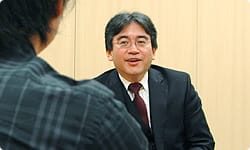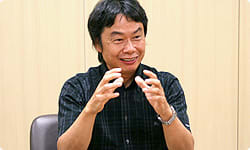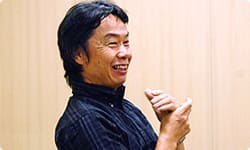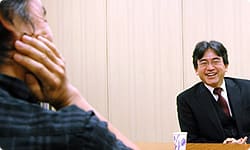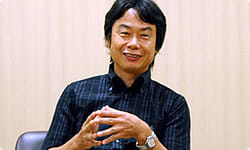"It’s Fun Just Playing Around"
Eleven years ago, when you released Super Mario 64, it felt like it had brought on the dawn of a new era. It was celebrated by people across the globe. But at the same time, the game had created a group of people who felt 3D games were something distant, as if it weren’t suited for them. But on the flip side, the game did increase the demand for us to make great Mario games that can surprise the world. Amidst all that, Super Mario Galaxy will be the long-awaited addition to the 3D action Mario games. Miyamoto-san, now that everything have come this far, would you please tell me what went through you mind, and how were you able to overcome the hurdles?
The reason that people felt distant to 3D action games, was because those games were easy for some people to get motion sickness, and how it was easy to get lost in the playing field. Having a background in industrial design, I was used to working with CAD. And since it’s my job to draw in 3D, I am unable to grasp how somebody who was playing a 3D game for the first time would feel, from a calm, objective perspective.
| *3. | CAD (Computer Aided Design): A method of designing things like products and architecture using computers. |
Miyamoto-san, you’re very used to understanding 3D space.
That’s because I’ve been doing it for so long . . . I have been trying to observe how ordinary
people would feel and react to it in the past, but this is so difficult for me because I am not
able to grasp these things myself. But another part of me really enjoyed making Mario 64. When I was a child, I played with marionettes, I drew manga in my student years, and when I started working I began making video games . . .
When I started making games, I was very excited in the fact that I was able to work in animating them. But at first, everything was all in 2D, and when we were finally able to work in 3D, I was happy that now I was able to look at Mario from every angle.
Miyamoto-san, before you worked on Mario 64, you had used the Super FX chip4 in the SNES to create a game like game Star Fox5, even with the limited hardware capabilities of the SNES. So looking at you working on Mario 64, it seemed as if you had been released from the limitations that had been confining you. There were so many things that you wanted to do using 3D, and it seemed like you took all that energy and exploded it towards Mario 64.
| *4. | The Super FX chip is a chipset that was built in some of the SNES cartridges. This chip made displaying 3D graphics possible. |
| *5. | Star Fox is a 3D shooting game for the SNES, released in 1993. |
The good part about Mario 64, was how you were able to freely move Mario around, who was now in 3D for the first time.
Being very blunt about this, I actually felt at one point that this didn’t really have to be a game.
You felt that it was so fun being able to move Mario around, it didn’t need anything else.
Right. There was no other game before Mario 64, where you were able to truly move around freely in a 3D environment.
It was great just being able to move Mario to find a star. But these days, there’s nothing new about a game being in 3D.
So in making Super Mario Galaxy, I thought about what is the distinct characteristic of the world of 3D Mario. This is actually something different from things like the storyline.
That’s right.
So what I had come up with, was gravity.
Gravity was used a lot in old movies, with things like being able to walk upside-down on the ceiling.
But if you think about it, nobody was really able to do that before in real life, and I though it would be great if I were able to recreate that in a game. People would be able to have a new experience, and it would be so much fun being able to play around in that kind of an environment.
But when I told that to the staff, they became worried, and asked me "Can we really call something like that a game?" So I told them, that if I were to make a game that was not fun, I would much rather make something that was not a game, but everyone would find a lot of fun! (laughs)
If something was fun from the ground up, the rest somehow works out. On the other hand, if a game is not fun, it wouldn’t work out unless you added on a lot of elements to it later.
Like a Vaudevillian6 in the olden days, I have an image in my mind where Mario is that kind of character that is this dapper, middle-aged man performing a lot of wonderful things in front of our eyes.
But at the same time I think that, I don’t think Mario is just some ordinary guy, and I wanted to make him cooler. That’s when the name "Super Mario Galaxy" had popped up, and when I heard this title, I felt a spherical field, gravity and galaxy were a perfect match for this. But that idea was objected by the staff.
| *6. | Vaudevillian is a term used to define a comedic entertainer from the olden days who would perform in places such as comedy shows and theater houses. |
Did they say "What? He’s now in space!?" (laughs)
They also said "I thought Mario was a fantasy game, is Mario going Sci-Fi now?" (laughs)
Beyond the terrains of land, sea and sky that Mario dashes through, space was the next step beyond all those things. They didn’t think that that space would be a good fit for a Mario world.
So I think with this game, it was a good opportunity to re-think what a fun, 3D action game should be, from the players’ perspective.
So the planning didn’t go perfectly smooth. Even with the spherical field, I had heard that it took a while for the concept to resonate with the staff.
I felt that this new Mario world not be fun if the screen just scrolled like the way it did in the past. I felt that since this was now in 3D, I had to step things up. When we worked on Paper Mario7 in the past, we had experimented with making a field that was in the shape of a roll, or a ball. However, these things didn’t work as I was expecting them to at the time, so I had put a hold on those ideas. When I further expanded on that concept with Mario 128, it worked really well. The field was even spherical, and the camera would follow Mario wherever he went. Looking at the way the players didn’t have to change camera angles, we felt that this could be used to lessen the chance of people getting motion sickness while playing. Because when the camera angles are fixed by the game designer and move in a way that’s not expected by the player . . .
| *7. | Paper Mario was an action RPG that was release on the Nintendo 64 in February 2001 in the US. |
Because the camera angle moves in unexpecting ways, it’s easier to get motion sickness.
It came down to finding the right idea. With a spherical field, you’re able to create new styles
from a design perspective, and this type of field is also good for the camera angles. So even after experimenting with Mario 128, I wanted to save it for another time.
I remember very well when you were saying how you wanted to make the next Mario in a spherical field. But at the time, I did not fully understand its benefits. I knew right away that visually, it would look great. But its true value was beyond what could be seen with the eyes, it was something that I hadn’t realized.
Since I wanted to the be the first one to bring it to reality, I was happy that nobody realized those things yet! (laughs) But I didn’t want that idea to be used somewhere else first, so I tried to build it in to "Doshin the Giant"8. When I told that to the staff, they said "No way! It’s too late!", and I wasn’t able to put it in the game on time! (laughs)
I see! (laughs)
| *8. | Doshin the Giant was a game that was released on the GameCube in March 2003 in Japan. (This game was not released in the United States) |

